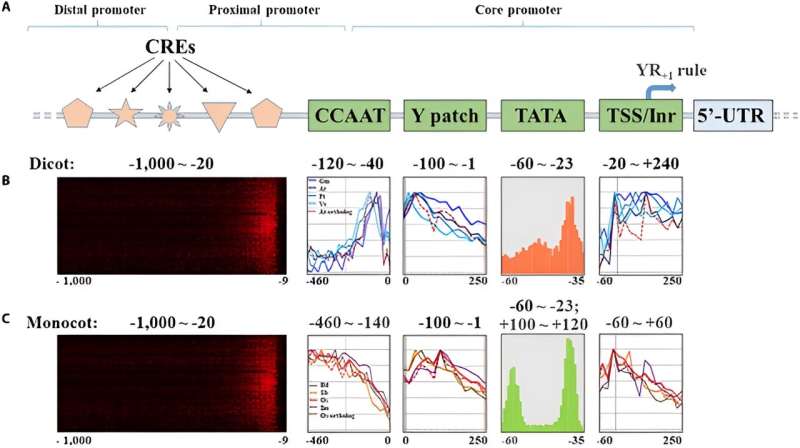This article has been reviewed according to Science X's editorial process and policies. Editors have highlighted the following attributes while ensuring the content's credibility:
fact-checked
trusted source
proofread
Decoding plant gene expression: A deep dive into promoters and terminators for advanced bioengineering

In high-precision bioengineering and synthetic biology, the fine-tuning of gene expression at transcriptional and posttranscriptional levels is essential. This involves a detailed understanding and manipulation of promoters and terminators, which regulate gene transcription.
Promoters control the timing, location, and level of gene expression, while terminators influence mRNA levels and various posttranscriptional aspects like stability and translation efficiency. The current research focuses on dissecting the function and features of plant core promoters and terminators, exploring their roles in gene expression regulation. However, a significant challenge remains in identifying optimal promoter-terminator combinations for efficient transcription in plant bioengineering.
In July 2023, BioDesign Research published a review article titled "Plant Promoters and Terminators for High-Precision Bioengineering."
In this review, authors delve into the intricacies of plant core promoters, proximal and distal promoters, and terminators, focusing on their roles and benchmarking strategies in regulating gene expression. Core promoters, vital in gene transcription, differ between dicots and monocots, as evidenced by variations in the distribution and composition of motifs like TATA-box, Inr, and CCAAT-box.
Notably, the TATA-box's presence significantly influences core promoter strength. In addition, nucleosome depletion regions (NDRs) in active core promoters with high content in G-C indicate the dynamic nature of nucleosomes, which is essential for transcription machinery accessibility. Intriguingly, mutations in TATA-boxes or Inr elements can induce nucleosomal structures, hindering expression.
This highlights the importance of core promoter chromatin architecture in gene expression. The review also covers the significant role of 5′-UTRs and leader introns in gene expression. Various plant promoters, characterized by a plethora of cis-regulatory elements in their proximal and distal regions, demonstrate the potential for engineering synthetic promoters with precise expression control.
It is worth noting that promoter strength can be modulated by combining different cis-regulatory elements, and machine learning algorithms offer promising avenues for predicting synthetic promoter expression patterns. Terminators, critical in transcriptional termination and mRNA processing, are explored in depth. Their complexity, including multiple polyadenylation signals and cis-termination elements, significantly impacts transgene expression levels.
Studies demonstrate that plant native terminators can surpass exogenous ones in enhancing gene expression. This review also highlights applications of promoters and terminators in plant design, underlining their pivotal roles in transformation, metabolic engineering, biosensing, and genome editing.
The combination of promoters with terminators is key in fine-tuning transgene expression, as evidenced by various studies showing the impact of promoter–terminator combinations on gene expression. Finally, the review emphasizes the need for comprehensive analysis and benchmarking of promoters and terminators for advancing plant synthetic biology.
In conclusion, understanding the intricacies of promoters and terminators is vital for advancing plant bioengineering. The ongoing integration of novel methodologies like RNA-seq and ATAC-seq promises enhanced discovery and characterization of cis-regulatory elements, enabling precision gene manipulation in plant synthetic biology.
The review emphasizes the importance of the contextual functionality of biobricks in heterologous systems, advocating a combination of empirical and fine-tuning approaches for desired outcomes in plant design.
More information: Emily G. Brooks et al, Plant Promoters and Terminators for High-Precision Bioengineering, BioDesign Research (2023). DOI: 10.34133/bdr.0013
Provided by NanJing Agricultural University





















